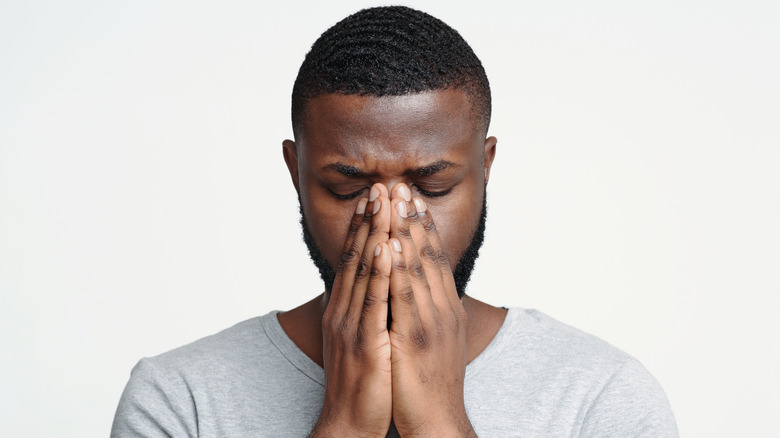The Real Reason You Get Headaches When The Weather Changes
Seasonal changes usually arrive with a flurry of signs. Shifts in temperature, new weather patterns, and changes in both the plant and the animal life all around us. But for some unlucky people, there is another sign that the seasons are changing and it's a lot less idyllic. For these people, seasonal changes — or major shifts in weather — also come with headaches. In some these become full-blown migraines.
It can be hard to tell the difference between a headache and a migraine and it usually comes down to a mix of location and severity. Both, however, can be set off by changes in the weather, including those that happen when we shift from one season to another. At least, according to most researchers.
The American Migraine Foundation's position is that changes in the weather can cause migraines and headaches. They point out, however, that there is little concrete proof. While many studies have found at least a small link between weather and head pain, a study of 238 patients from Vienna, Austria concluded that the link was "small and questionable."
Of course the link hasn't been under scrutiny for very long. And it is normal for scientific opinions to shift and change as new studies come out. Which is why the American Migraine Foundation posted another article in 2017, this one soundly supporting the link between head pain and weather changes. They even give a specific reason for the connection.
Your sinuses under pressure
Dr. Cynthia Armand works at Montefiore Medical Center in New York State. She specializes in the effects weather and seasonal changes have on migraines. So when she sat down with the American Migraine Foundation in 2017, she was very clear on the latest science.
Changes in the weather — including temperature shifts and changes to an area's precipitation level — involves a change in atmospheric pressure which is also known as barometric pressure. When this pressure changes it affects the pockets of air in our heads known as sinuses. For those prone to headaches or migraines, this sets off an episode. Rapidly changing weather can create clusters of headaches that can knock a person off their feet for a few hours or a few days.
The Mayo Clinic also says that changes in weather may cause changes in certain brain chemicals which can set off migraines or headaches. This is also backed up by Dr. Armand who found that changes to sleep cycles — such as those that happen when days get much longer or much shorter in summer and winter — can trigger migraines. In both cases our brains struggle with serotonin and dopamine levels which is a common migraine trigger according to the Migraine Relief Center.
A change in the weather does not doom anyone to a migraine, of course. Triggers are complex and can change over time. But if you suffer frequent migraines or cluster headaches when it storms or a new season rolls around, you might find some relief with these handy tips.


